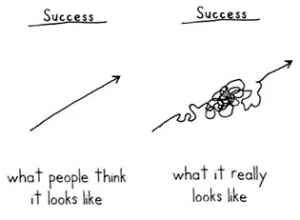 the genius behind inbound marketing, issued a challenge — blog for 30 days. What? In a row?!? How crazy was that idea! I was lucky if I managed to eek out one blog a week! I certainly wasn’t capable of writing one blog every day — especially given my current blogging state of mind.
the genius behind inbound marketing, issued a challenge — blog for 30 days. What? In a row?!? How crazy was that idea! I was lucky if I managed to eek out one blog a week! I certainly wasn’t capable of writing one blog every day — especially given my current blogging state of mind.
I’m not exactly a blogging aficionado. A blog post took 4-5 hours to construct. I struggled with topics, content, sentence structure — you name it. I fidgeted. I snacked. I stressed. I struggled with what to say and how to say it. It was a painful process. Certainly, 30 days of this activity would be sheer torture.
Was I “in”? You bet!
Always up for a challenge, I was curious to discover what 30 days of blogging would do for my small business. At worst, I could pull the plug at any time. Besides creating some astonishing results, the self-discovery was more astonishing.
- Reams of information are stored in my brain. Before the 30-day challenge, I didn’t have much to say…or so I thought. If I didn’t have something worthwhile to share, my lips were sealed. After 30 continual days of writing, I’m amazed at what runs through my brain.
- A blog post takes 90 minutes. Blogging requires less time each day. The mere act of daily writing creates a rhythm that makes blogging more efficient.
- Writing is easier. The regularity of engaging my brain in the craft makes writing more comfortable. I wouldn’t say its stress-free but I fidget less. I “almost” look forward to writing.
- Early morning is my best time. One of my blogging challenges was finding the best time. By late afternoon my brain was littered with the days activities. Midday sounded good…at first. Once email reared its head, all bets were off. Finally, I found my groove at 6 am before the rush of the day while my brain was fresh.
- The results were awesome. Shocker! It really is true. Companies that blog 15X or more per month get 5X more traffic than companies that don’t blog. Nailed it!
I still struggle with headlines and wonder if the post is good enough but, like strengthening a muscle, blogging is easier with time and practice. I’m pretty certain I’ll never be as gifted a writer as Scott Siders of Novowriting but I’m pretty dog-gone happy with my progress.
What will I do for an encore? Given the results of the previous 30 days, I’ll continue my blogging quest Monday – Friday. Care to join me?



 How many times a day do you say, “I don’t have time” or “I don’t have enough time”? Lack of time is a common problem that plagues every small business owner. A rock-solid solution to create more time is needed in today’s time-crunched environment.
How many times a day do you say, “I don’t have time” or “I don’t have enough time”? Lack of time is a common problem that plagues every small business owner. A rock-solid solution to create more time is needed in today’s time-crunched environment.


 Seems like it was in the 80’s when I began to lose grip on my personal definition of success. Given the culture of my profession at the time, I succumbed to the pressure to “do more” and “have more”. This “more” approach to life actually created less. I had less sleep, failing health, struggling marriage, fewer friends…all for “more money and stuff”. Could it have been any more irrational equation?
Seems like it was in the 80’s when I began to lose grip on my personal definition of success. Given the culture of my profession at the time, I succumbed to the pressure to “do more” and “have more”. This “more” approach to life actually created less. I had less sleep, failing health, struggling marriage, fewer friends…all for “more money and stuff”. Could it have been any more irrational equation?
 is a general term used to describe the behavior of people and animals that leads them to accumulate food and other items during times of scarcity. Similarly, mental hoarding is the accumulation of thoughts and beliefs.
is a general term used to describe the behavior of people and animals that leads them to accumulate food and other items during times of scarcity. Similarly, mental hoarding is the accumulation of thoughts and beliefs.
 Just like I tried to coax myself out of the hike, small business owners are not much different. We expend precious resources in an attempt to identify legitimate “reasons” (aka excuses) to avoid the very actions that ensure the success of our goals. Whether it’s the new program release we’ve dreamt of for months or an over-due rate increase we intended to implement (and didn’t), the mind creatively generates all sorts of “valid reasons” to avoid action.
Just like I tried to coax myself out of the hike, small business owners are not much different. We expend precious resources in an attempt to identify legitimate “reasons” (aka excuses) to avoid the very actions that ensure the success of our goals. Whether it’s the new program release we’ve dreamt of for months or an over-due rate increase we intended to implement (and didn’t), the mind creatively generates all sorts of “valid reasons” to avoid action.


 Like Santa and M&M’s, the
Like Santa and M&M’s, the 
 Ask a small business owner, “how are things going” and you’ll likely hear “okay”. This means things aren’t going as planned. Occasionally, the atypical case exists when “things” are planned and events trigger a change to plans made. However, if things aren’t going as planned, it’s because many small business owners haven’t taken the time to plan.
Ask a small business owner, “how are things going” and you’ll likely hear “okay”. This means things aren’t going as planned. Occasionally, the atypical case exists when “things” are planned and events trigger a change to plans made. However, if things aren’t going as planned, it’s because many small business owners haven’t taken the time to plan.

